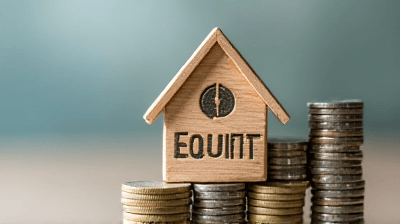
Home equity—the difference between your home’s market value and the remaining balance on your mortgage—is a powerful financial asset that can be leveraged to build wealth. In 2025, with home prices stabilizing in many markets and interest rates hovering around 6 to 7 percent, homeowners have opportunities to tap into their equity strategically. Whether you’re looking to invest in additional properties, fund renovations, or diversify your portfolio, using home equity wisely can accelerate your financial growth.
Understanding Home Equity in 2025
Home equity represents the portion of your home you own outright. For example, if your home is worth 500000 dollars and you owe 200000 dollars on your mortgage, your equity is 300000 dollars. In 2025, home equity levels remain significant for many homeowners, as property values have appreciated steadily in recent years, particularly in high-demand areas like Austin, Charlotte, and Phoenix.
However, leveraging home equity involves borrowing against this asset, which introduces risks. Interest rates in 2025 are higher than the historic lows of the early 2020s, and economic uncertainty makes careful planning essential. By understanding the tools and strategies available, you can use your home equity to build wealth while minimizing financial strain.
Ways to Access Home Equity

There are three primary methods to tap into your home equity: home equity loans, home equity lines of credit (HELOCs), and cash-out refinancing. Each has unique features, benefits, and drawbacks.
1. Home Equity Loan
A home equity loan provides a lump sum based on your equity, repaid over a fixed term (typically 5 to 20 years) at a fixed interest rate. In 2025, rates for home equity loans average 7 to 9 percent, depending on your credit score and loan-to-value (LTV) ratio.
Pros: Predictable payments, lower rates than unsecured loans, and suitable for large, one-time expenses.
Cons: Higher rates than primary mortgages, and defaulting risks foreclosure.
2. Home Equity Line of Credit (HELOC)
A HELOC is a revolving line of credit, allowing you to borrow as needed up to a set limit, similar to a credit card. In 2025, HELOCs typically have variable rates tied to the prime rate, averaging 8 to 10 percent.
Pros: Flexibility to borrow only what you need, with interest-only payments during the draw period (usually 10 years).
Cons: Variable rates can rise, increasing costs, and disciplined repayment is required to avoid debt accumulation.
3. Cash-Out Refinancing
Cash-out refinancing replaces your existing mortgage with a larger one, allowing you to pocket the difference in cash. In 2025, mortgage rates for cash-out refinances are slightly higher than standard refinances, around 6.5 to 7.5 percent.
Pros: Potentially lower rates than home equity loans or HELOCs, and you can reset your mortgage term.
Cons: Higher closing costs (2 to 5 percent of the loan) and a longer repayment period may increase total interest paid.
Choosing the right option depends on your financial goals, risk tolerance, and how you plan to use the funds. In 2025, HELOCs are particularly popular due to their flexibility, but cash-out refinancing may be better for those seeking lower rates and a single loan.
Strategies for Leveraging Home Equity to Build Wealth
Using home equity effectively requires a clear plan to generate returns that outweigh borrowing costs. Below are five strategies to leverage home equity for wealth building in 2025.
1. Invest in Additional Real Estate
One of the most common ways to use home equity is to purchase investment properties, such as rental homes or fix-and-flip projects. Real estate can generate passive income and appreciate over time, amplifying your wealth.
How it works: Use a HELOC or cash-out refinance to fund the down payment on a rental property. For example, a 50000-dollar HELOC could cover a 20 percent down payment on a 250000-dollar rental home. If the property generates 2000 dollars monthly in rent with 1000 dollars in expenses, you net 12000 dollars annually, outpacing the 8 percent interest on the HELOC.
2025 considerations: Focus on markets with strong rental demand, like Raleigh or Boise, where vacancy rates are low (around 5 percent) and rents are rising. Research local landlord laws to avoid regulatory pitfalls.
Tips: Choose properties with high rental yields (6 to 8 percent) and ensure your cash flow covers loan payments and maintenance.
2. Fund Home Improvements
Renovating your existing home can increase its value, creating forced appreciation. In 2025, high-ROI renovations like kitchen remodels, bathroom additions, or energy-efficient upgrades (e.g., solar panels) can boost your home’s market value significantly.
How it works: Use a home equity loan to finance renovations. For example, spending 50000 dollars on a kitchen remodel could increase your home’s value by 75000 dollars, yielding a 50 percent ROI. Alternatively, renovations can make your home more appealing to renters, increasing rental income.
2025 considerations: Focus on upgrades that align with buyer preferences, such as open floor plans or smart home features. Avoid over-improving beyond what your neighborhood supports, as this limits returns.
Tips: Get multiple contractor quotes and budget 20 percent extra for unexpected costs. Check local permitting requirements to avoid delays.
3. Pay Off High-Interest Debt
Using home equity to pay off high-interest debt, such as credit cards or personal loans, can free up cash flow for other investments. In 2025, credit card rates average 20 to 25 percent, far exceeding home equity loan or HELOC rates.
How it works: Take out a home equity loan to pay off 30000 dollars in credit card debt at 22 percent interest. With a home equity loan at 8 percent, you save 4200 dollars annually in interest, which can be redirected to savings or investments.
2025 considerations: This strategy only works if you avoid accumulating new debt. Economic uncertainty in 2025 makes disciplined budgeting critical.
Tips: Work with a financial advisor to ensure debt consolidation aligns with your long-term goals. Focus on paying off the home equity loan quickly to reduce interest costs.
4. Diversify Your Investment Portfolio
Home equity can fund investments outside real estate, such as stocks, bonds, or small businesses, diversifying your portfolio and reducing risk. In 2025, with stock markets showing volatility, diversified investments can provide stability.
How it works: Use a cash-out refinance to access 100000 dollars in equity and invest in an index fund with an average annual return of 7 to 10 percent. If the fund outperforms your loan’s 7 percent interest rate, you generate net gains.
2025 considerations: Consult a financial advisor to choose low-cost, diversified investments like ETFs. Be cautious of market volatility and avoid speculative investments like individual stocks or cryptocurrencies.
Tips: Ensure your investment returns exceed borrowing costs. Maintain an emergency fund to cover loan payments during market downturns.
5. Start or Expand a Business
Home equity can provide capital to launch or grow a business, which can generate significant returns if successful. In 2025, small businesses in sectors like e-commerce, renewable energy, and healthcare are thriving.
How it works: Use a HELOC to fund a 50000-dollar startup, such as an online retail business. If the business generates 100000 dollars in annual profit, the returns far exceed the HELOC’s interest costs.
2025 considerations: Business ventures are risky, especially in a high-interest-rate environment. Conduct thorough market research and create a detailed business plan.
Tips: Start small to test your business model. Use a HELOC for flexibility, as you can draw funds as needed during the startup phase.
Risks of Leveraging Home Equity

While home equity can be a powerful tool, it comes with risks that require careful management.
1. Risk of Foreclosure
Borrowing against your home means using it as collateral. If you can’t repay the loan or HELOC, you risk foreclosure, losing your home. In 2025, with higher interest rates, ensure your income can cover loan payments, even if unexpected expenses arise.
2. Higher Interest Costs
Interest rates in 2025 are higher than in previous years, increasing the cost of borrowing. Variable-rate HELOCs are particularly risky if rates rise further, potentially doubling your payments during the repayment period.
3. Reduced Equity
Tapping into your equity reduces your ownership stake in your home. If property values decline, you could owe more than your home is worth (negative equity), especially with cash-out refinancing.
4. Overleveraging
Borrowing too much can strain your finances, especially if investments underperform. In 2025, economic uncertainty makes conservative borrowing critical to avoid overextending yourself.
5. Market Volatility
Real estate and financial markets are unpredictable. A downturn in 2025 could lower your home’s value or reduce returns on investments funded by equity, making it harder to repay loans.
Practical Steps to Leverage Home Equity in 2025
To use home equity effectively, follow these steps tailored to the 2025 market.
1. Assess Your Equity
Calculate your home equity by obtaining a current appraisal or using online tools like Zillow’s Zestimate. Subtract your mortgage balance to determine your available equity. Most lenders allow you to borrow up to 80 to 90 percent of your equity, depending on your credit and LTV ratio.
2. Compare Financing Options
Shop around for home equity loans, HELOCs, or cash-out refinances. In 2025, online lenders like Rocket Mortgage or traditional banks like Wells Fargo offer competitive rates. Compare:
Interest rates and fees.
Repayment terms and flexibility.
Closing costs, which are higher for cash-out refinances.
Consider locking in a fixed rate for stability, especially if you expect rates to rise further.
3. Develop a Clear Plan
Define how you’ll use the funds and calculate expected returns. For example, if investing in a rental property, estimate rental income, expenses, and appreciation potential. Ensure returns exceed borrowing costs by at least 2 to 3 percent to justify the risk.
4. Work with Professionals
Consult a financial advisor to align your strategy with your goals. For real estate investments, partner with a real estate agent or property manager familiar with your target market. In 2025, local expertise is crucial due to varying market conditions.
5. Monitor Your Debt-to-Income Ratio
Lenders typically require a debt-to-income (DTI) ratio below 43 percent. Calculate your DTI by dividing monthly debt payments (including the new loan) by your gross monthly income. A lower DTI improves loan approval odds and reduces financial stress.
6. Build a Safety Net
Maintain an emergency fund with 3 to 6 months of expenses to cover loan payments during unexpected setbacks. This is especially important in 2025, with economic uncertainties like potential recessions or job market shifts.
Case Study: Leveraging Home Equity in 2025

Consider John and Lisa, homeowners in Raleigh, North Carolina. Their home is worth 600000 dollars, with a 250000-dollar mortgage balance, giving them 350000 dollars in equity. They want to invest in a rental property to build wealth.
They take out a 100000-dollar HELOC at 8 percent interest, using 80000 dollars for a 20 percent down payment on a 400000-dollar rental property. The property generates 3000 dollars monthly in rent, with 1500 dollars in expenses (including the HELOC payment), netting 18000 dollars annually. The property appreciates at 5 percent per year, adding 20000 dollars to its value.
After five years, the property is worth 510000 dollars, and they’ve earned 90000 dollars in net rental income. Their total return (110000 dollars) far exceeds the HELOC interest (approximately 40000 dollars), demonstrating the power of leveraging equity. By choosing a high-demand market and budgeting carefully, they minimize risks and build wealth.
Conclusion
Leveraging home equity in 2025 offers homeowners a unique opportunity to build wealth through real estate investments, home improvements, debt consolidation, or diversified portfolios. By using tools like home equity loans, HELOCs, or cash-out refinancing, you can access capital to fund high-return opportunities. However, the risks of foreclosure, higher interest costs, and market volatility require careful planning. Assess your equity, compare financing options, and develop a clear strategy to ensure returns outweigh costs. With discipline and research, home equity can be a cornerstone of your wealth-building journey in the dynamic 2025 market.
